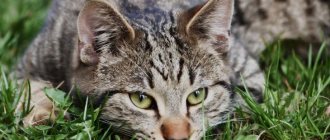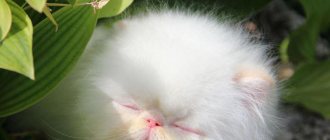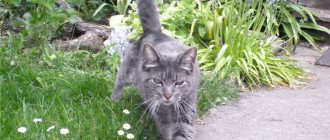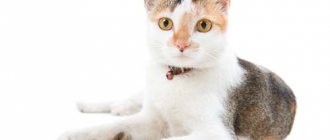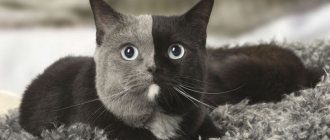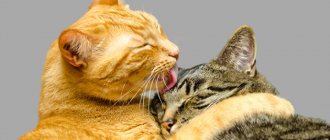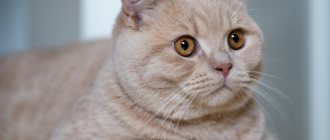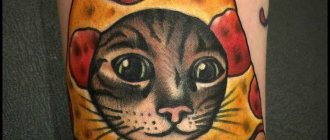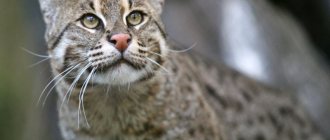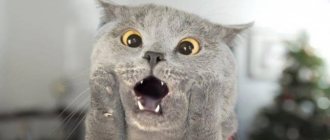The European cat is a short-haired breed with pronounced hunting instincts. It is generally accepted that it was this breed that was first domesticated and began to live in the home of an ancient person.
To emphasize the historical origin of the animal, the association of felinologists WCF assigned the name Celtic Smoothhair to the breed. But the new terminology did not take root among owners and breeders.
Origin story
The European Shorthair breed is recognizable and popular no less than the British one.
The progenitors of this breed include both wild European and Nubian breeds, but the historical component remains a mystery to this day, shrouded in darkness. The following is known for sure: for the first time a representative of this breed was presented in 1938, at an exhibition in Berlin. The beautiful Wastl von der Kohlung, a large, dignified silver-merle cat, amazed the audience. However, they did not want to register these cats as a separate breed for quite some time. They were classified as British, and accordingly, the appropriate standards were used.
Most of the representatives of the “Europeans” simply stopped breeding over time, but British cat lovers did not want to give up. In an effort to improve the breed - to make the undercoat thicker, to preserve small ears and head, but to increase the massiveness of the body and make the animal stronger - they continued the selection work.
In 1982, the world-famous FIFe divided the breeds, introducing one standard for “British” and another for “European”.
There is another name for the breed - Celtic Shorthair. It indicates the Scandinavian origin of these cats.
Castration of cats and female cats
Castration does not in any way affect the psyche of animals in a negative way; on the contrary, such animals live longer, more calmly and happily. Another thing is that they may gain weight, but this can be easily avoided with diet. The benefits of castration far outweigh the minor and not so common disadvantages.
This operation is best performed before your pet is one year old. If you notice that your cat begins to mark his territory with urine, this means that he has reached puberty and you can already go to the veterinary clinic for surgery. Castration of a cat as such is not particularly difficult. It is performed under general anesthesia, and after the operation the animal must stay at home for five days without going outside. Minor traces of a scalpel quickly heal, and you just need to keep the toilet clean, changing the filler more often to prevent infection from getting there. On the first day after surgery, you should not allow your cat to rub its lower body on the floor. It is necessary to monitor the condition of the wound so that there is no swelling.
Castration of a cat is a more serious intervention. It should be carried out when the cat’s body is fully formed - approximately six to eight months. This is a abdominal operation and after it, the cat needs intensive home care for two to three days. You should build a flat bed for her, covered with a woolen blanket and a linen sheet, constantly pay attention to the cat’s breathing and make sure that she does not freeze. After recovering from anesthesia, you need to give her clean water, and you can feed her only for the next day, starting with broths and light food.
Standards
Externally, European shorthair cats resemble the familiar “Barsiks” and “Murziks” running around the streets, the so-called classic domestic cats. Males are large and strong, sometimes weighing 8, or even 9, kilograms. Females are smaller, with an average weight of 4.5-5 kg.
| Standard | Description |
| Head | Large, with a round and long muzzle. The forehead is rounded, like the skull. The nose is smooth, of medium length, with a noticeable dimple at the transition to the forehead. The chin is clearly defined, strong, strong-willed. The neck is of medium length. The cheeks are slightly protruding, round, well-fed. |
| Eyes | Round, slightly slanting, wide open. The iris can be painted in any color (heterochromia is also allowed, i.e. one eye is amber, the other is light blue), but the color must be uniform. |
| Ears | Medium size, with rounded ends. Some individuals have small tassels growing on their ears. They stand vertically, at a short distance from each other. |
| Torso | Powerful, with well-developed muscles. The chest is round and well developed. |
| Limbs | Medium length, strong, proportionally developed. The paws are round, the pads are elastic, pink or gray. |
| Tail | Thick at the base, tapering towards the end. The tip is rounded. |
| Wool | Shiny, elastic and thick. It is hard to the touch and fits tightly to the body. |
The following are considered defects of the breed: sagging cheeks;
clear “stop”; presence of genes from other breeds; short, weakly defined chin; broken crooked tail; too long coat.
Advantages and disadvantages
In terms of anatomical characteristics, this is the most undemanding option: good health, moderate shedding, omnivorous.
For owners of a private home, this is the best option. The European is an excellent mousecatcher, faithfully defends its territory and loves to soak up the outdoor sun. This is a plus for a family home due to the playfulness and non-aggressive nature of the breed. You can safely leave your children with a cat without fear of a conflict of interest. This breed has many advantages for independent people. If a person works a lot outside the home or cannot give the cat enough attention, it will cope with its interests on its own.
The negative aspects are associated with the cat's activity at night, as well as territorial protection from rodents and small birds, so other pets may be in danger when living with it.
Reviews of the European Shorthair on Irecommend:
- “The cat is cool! A little harmful character, but a fun and interesting life is guaranteed. And there is little hassle with him. Little fur, almost no mischief and no screaming. Loves to sleep with his owners. And we love to sleep with him. He is soft, fluffy, lies calmly even all night. In winter it’s a super warmer! It’s pleasant for both soul and body.”
- “This is a dream cat. A friend to whom you come to tell all your worries, sometimes cry, sometimes squeeze. And she endures all this with the patience of a Goddess. And then he turns on the engine and starts it to calm and lull the owner. If you’re sick, she’s nearby, if you’re sad, then right there.”
- “My cat is amazingly positive and cheerful. She is always in a good mood, she rarely gets offended, she is always happy to see you. You look at her and your mood improves. I also noticed that she likes to change her place of rest - she sleeps in one place, then in another. Wayward. It happens that she herself requires solitude, so that she will not be touched. It’s the same with food, sometimes he refuses his favorite food and waits for another package to be opened, but he won’t touch it. The next day he eats it again with appetite.”
Colors
The color palette of the European Shorthair cat is rich in shades. The following are allowed:
- Tricolors: tortoiseshell (including bluish-cream, chocolate, lilac, white shades);
- Marble: lilac-silver, chocolate-silver, silver with blue or black, chocolate, black, blue, red, cream;
- Tiger (shades like marble ones);
- Bicolors: white combined with black, cream, red, blue, chocolate, lilac);
- Spotted: there are 2 dozen options;
- Shaded (veiled) black, blue, lilac, red, smoky, cream, white with orange or blue eyes.
The photo shows a cat of the European Shorthair breed, colors: bicolor, brindle, marbled.
Currently, more and more breeders are interested in breeding cats with unusual colors: golden and silver.
But point colors, so popular among the “British,” are not recognized among the Celts. Official communities believe that since this breed is native, unnatural colors should not be introduced into it.
What are the advantages and disadvantages of the European Shorthair cat breed?
This cat has adapted well to the demands placed on humans. For business people who do not have enough time to painstakingly care for a cat, the most reasonable thing would be to focus their attention on this breed.
Table: comparative characteristics of the Celtic cat breed
| Advantages | Flaws |
| Relatively low cost of a kitten. | Simple appearance, very close to the appearance of non-pedigreed cats. |
| Undemanding in care, nutrition and maintenance. | Low popularity of the breed in Russia. |
| High level of health. | Lack of nurseries in the country. |
| Friendly character, good attitude towards children and other family members, ability to be alone. | |
| Quickly masters the litter tray and other rules of behavior in the house, cleanliness. | |
| Has the instincts of a good hunter and can protect the house from rodents. |
Character and behavior
Who knows, the European cat is ideal as a pet. She has a lot of positive qualities: flexibility, kindness, lack of aggression, friendliness. From the very first days of its appearance in the house, the animal chooses its leader and begins to literally copy his behavior, adopting the most striking habits, adapting to his regime and gradually turning into a smaller copy of him.
Cats of this breed have one funny feature: when they are very frightened, their paw pads, ears and nose become bright pink. Have you noticed that your pet is blushing? Calm her down quickly!
“Europeans,” while firmly attached to the leader, do not ignore the rest of the family. Quite the opposite: all household members will receive a portion of the cat’s attention and affection. Cats are especially drawn to children: they willingly play chase and hide-and-seek with them, lick their hands and feet, and go to sleep in the same bed with them. And even if the baby hurts the cat, they will not try to bite him, much less take revenge in the future. That is why “Europeans” are so popular in large families.
“Europeans” are playful, but they are also great at entertaining themselves. Buy your cat a few toys and he won't bother you unless you're in the mood to race around the apartment.
Are a cat's pupils the same during the day and at night?
Not really
“Europeans” quickly find a common language with other animals: in any case, they can easily make friends with cats and dogs. But hamsters, rats, guinea pigs and small birds are a source of danger for them. More precisely, not even for them: “Europeans” classify them as pests and do their best to protect household members from their presence in the apartment. In addition, cats of this breed have a well-developed hunting instinct, so be prepared that your little predator will often be “active” at night, running around rooms and dropping objects.
“Europeans” rarely raise their voice – only if something out of the ordinary happens. They often prefer to communicate with their eyes.
They are smart and understanding, so your task is to accustom the kitten to order from an early age. Eat in one place, sleep on a separate bed, walk on a leash. Speaking of walks: European Shorthairs are not afraid of cars or other people, so you can go for walks with them from time to time. But you shouldn’t practice free walking: curiosity can lead a cat too far from home.
Expert opinion
Dusheba Vera Ivanovna
In 2010, she graduated from the Moscow State Academy of Veterinary Medicine named after K.I. Scriabin with honors, specializing in veterinary medicine. I regularly attend veterinary conferences, congresses, and webinars.
Unfortunately, there are no nurseries in Russia that specialize in raising this particular breed. Therefore, you can buy a kitten either from private breeders or abroad. The price depends on how many titles his father and mother had, as well as on the class of the baby itself, and varies from 2 to 15 thousand rubles from a private person, and from 25 to 45 thousand rubles from a foreign nursery (plus delivery).
Take a kitten at the age of 3-4 months: by this age the baby will be taught to eat and go to the litter box on his own (read the article on the topic How to train a kitten to use the litter box?), will be given the necessary vaccinations, and it will be easier for him to adapt. Choose a strong and healthy baby: with clean ears and eyes, shiny and thick fur. The animal must not be aggressive or slaughtered. The following documents must be present: a kitten’s passport indicating its name, date of birth, information about parents and vaccinations; contract of sale.
How to breed a European Shorthair cat
When starting to breed a breed, remember that the first mating is the most important. For cats of this breed, it is best to carry it out during the third heat cycle, that is, at about one and a half years. A month before mating, it is necessary to undergo an examination by a veterinarian, receive vaccinations, if necessary, and undergo deworming.
In order for your cat’s offspring to be highly valued in the feline society, she must first participate in some cat shows
If your pet has been awarded the champion title, you immediately acquire a high rating in the field of breeding. But even in case of failure, all exhibitors receive an assessment based on the level of value of the animal for breeding. Based on this criterion, you select a worthy partner for your pet in advance. In this case, you need to take into account:
- in the WCF and FIFE exhibition systems, breeding work, including the search for partners, is carried out only through the club; in order to engage in breeding, you must be a member of any club that unites cat breeders;
- in the American exhibition system TICA and CFA, breeders are responsible for the result of their work, and it is not necessary to be a member of a felinological club.
If all the organizational part is completed, on the third day of estrus you take the cat to your partner and leave him there for several days. The cat owner will take care of your pet during this time and supervise the mating.
The act of mating is confirmed by a document indicating the following information:
- details of partners, their titles and pedigrees;
- information about the owners;
- mating conditions;
- time spending.
The document is drawn up in two copies, and copies of the pet owners’ passports are added to it.
What a cat owner needs to consider
The first mating of a cat is carried out at its full sexual maturity, which occurs after about a year and three months. Usually, young cats are looking for more experienced partners.
Mating is carried out on the male's territory, so the owner must ensure the safety of the animals throughout the entire period. Ideally, the cat has a fenced-off enclosure, in which there are no breakable or breakable objects, it is impossible to hide in any crevice, and a protective mesh is installed on the windows.
Payment is made by agreement and usually after a confirmed pregnancy.
Care instructions
Caring for a European Shorthair cat is not as difficult as, for example, a Persian or Oriental. But the basic rules remain the same.
Eyes
Examine your pet's eyes once a week and remove any discharge, if any. It's simple: moisten a cotton sponge (you shouldn't use cotton wool - inflammation can develop if particles get on the mucous membrane) in a special eye lotion (or a fresh decoction of chamomile, or plain boiled water) and gently blot the corners of the eyes.
Ears
The ears of “Europeans” are large and almost smooth from the inside, so dust and dirt accumulate in them in excess, not to mention wax. They also require weekly cleaning using a special solution and cotton swabs.
But be careful! Any careless movement can lead to injury and inflammation. Do not try to insert the stick into the ear canal itself; clean only the visible part of the ear. Don't put anything inside!
Wool
Care also includes brushing - at least once a week - with a brush with natural bristles. You can bathe a “European”, but every week. Frequent bathing leads to the fact that the animal begins to suffer from dermatitis, and its coat loses its natural shine. Bathing is necessary before the exhibition, if the cat is very dirty or before giving birth. Use special shampoo: “Bars”, “Doctor ZOO”, Iv San Bernard “Lemon”.
Teeth
Regular brushing will help keep your teeth healthy and strong. Since the animal is not able to do this, you, as the owner, will have to do it yourself. Buy a soft brush (soft silicone or with natural bristles) and a special toothpaste (Trixie, Beaphar Toothpaste, Hartz) from a veterinary pharmacy, and brush your cat’s teeth several times a month. In addition, take your cat to the veterinarian once a year for an oral health check.
For some Celtic cats, such a procedure as brushing their teeth turns into real torture. The animal becomes so stressed that it breaks out and tries to bite and scratch.
To make the task easier, a dental spray (Sentry Petrodex Dental Spray, Api-San Zubastik, Beaphar Fresh Breath Spray), water additives (TropiClean Water Additive Original, Cliny) or snacks (Mnyams Healthy Teeth, GimCat Denta-Kiss) will help , Beaphar Cat-a-Dent Bits.
Claws
The “European” is good at sharpening his claws himself, but your task is to buy him a strong and comfortable scratching post, and trim his claws with a nail clipper once a month.
The photo shows a cat of the European Shorthair breed, tricolor color
Choosing and caring for a kitten
When choosing a kitten of the European breed, you should not take risks and buy it on the market. It is best to choose it in a special nursery. A representative of this breed must have all the relevant documents.
European kittens need the same care as adult cats. They are vaccinated already at the eighth week, if the mother cat has not been vaccinated. If the cat has been vaccinated, the kitten can be vaccinated at 12 weeks. It is recommended to avoid vaccinations while changing teeth. It begins at four months and lasts until seven.
Proper animal care, balanced nutrition and timely vaccinations will help the cat grow healthy and active and delight its owners.
Catering
The owner has the right to choose what he will feed his pet: natural food or prepared food. European shorthair cats do not require any specific nutrition and are not prone to overeating, which means that they are not at risk of obesity. But the owner should remember some rules.
Holistics
When choosing industrial food, take into account the individual needs of the pet, its physical characteristics: age, health, weight. Holistics are considered the best in quality. These foods use fresh and dehydrated meat, fish fillets, natural preservatives, berries, fruits and vegetables. In addition, it contains a good vitamin and mineral supplement. Examples: Acana, Wildcat, Pronature Holistic.
Super premium
Super premium food is in second place and differs from holistic food in the smaller amount of meat. However, the amount of meat, meat ingredients, vegetables and nutrients in general allows you to use these foods without fear. And they are cheaper than holistic feeds. Examples: Brooksfield, Guabi Natural, Arden Grange.
Premium and Economy
Premium and economy food are cheaper than those mentioned above, but they practically do not receive approval from cat owners. They most often contain meat waste (bones, skin and tripe, not meat), allergy-causing wheat and corn, vegetable proteins, antioxidants and preservatives of unknown origin. Premium food samples: Eukanuba, Night Hunter, Safari. Economy group foods include Whiskas, All Cats, Perfect Fit.
Below are recommended super-premium and holistic foods. Links with the names of the food are clickable, on them you can, within our website, get acquainted with the descriptions of the food and read reviews from owners of European Shorthair cats.
| Premium | Super premium | Holistic |
| Wahre Liebe | Natyka | Farmina N&D |
Health and life expectancy, diseases and vaccinations
Eastern European cats are characterized by good health and can live up to 15 years or more.
European breed cat
Due to the fact that no other breeds were used in breeding this species and only the best specimens were crossed with each other, the European cat is in good health. There are no hereditary diseases, no developmental defects are observed. Cats receive standard vaccinations.
Natural products
From natural products it is allowed to give:
- Frozen fresh beef (for a kitten - from 30 grams, for an adult animal - 100-120 grams) is given at least 3 times a week.
- Chicken, turkey, veal, and rabbit meat (in the same quantities) are given 2-3 times a week.
- By-products (ventricles, kidneys, hearts, liver, necks) - 2-3 times a week. Raw or cooked (the liver must be boiled).
- Sea fish (hake, salmon, trout, salmon, cod) - no more than once a week. Excess fish leads to the formation of kidney stones, in addition, it impedes the absorption of vitamin B.
- Fermented milk products (medium fat kefir, cream, sour cream, fermented baked milk, Varenets, cottage cheese, natural yogurt) can be given daily. They should not contain dyes or harmful components.
- Boiled chicken and quail eggs (from chicken eggs - only the yolk) - 1-2 times a week.
- Cereals (millet, rice, oatmeal, buckwheat, pearl barley) – 5 times a week.
- Stewed, boiled or raw vegetables (pumpkin, carrots, zucchini, green beans, cauliflower), as well as greens (spinach, lettuce, dill) are added to porridge.
- Brewer's yeast (dry) - according to instructions.
- Vegetable or olive oil - 3-4 drops in porridge.
- Vitamin supplements - in agreement with the veterinarian.
Sprouted grains of wheat or oats - a container with grass is placed in a convenient place, and the cat feasts on it at will.
Clean water should always be poured, purified and at a comfortable temperature for drinking. You cannot give your animal juices, mineral water, tea or other human drinks.
You cannot give:
- Offal, skin, bones, lard;
- Lamb, pork, goose and duck meat;
- Sweets, baked goods, flour, smoked, salty, sour;
- Human canned food, sausages and frankfurters;
- Salt, sugar, spices, sauces, mayonnaise;
- Potatoes, beans, avocados, tomatoes, eggplants;
- Vitamins and supplements for people.
Kittens up to 3 months eat 6 times a day, up to six months - 3-4, older - 2 times. An exception is made for animals weakened after illness; cats bearing and feeding offspring; older animals.
The photo shows kittens of a European shorthair cat
Keeping a European Shorthair Cat
One of the advantages of this breed is its low requirements for care and nutrition. But in order for your pet to always look great and maintain its health for a long time, you must follow the basic rules of keeping a cat.
Hygiene procedures and pet appearance
Cat care includes the following procedures:
- Examine your eyes daily and remove any discharge with a damp swab (use a separate swab for each eye); For wetting, you can use tea, chamomile or boiled water. A large amount of discharge, redness of the cornea or the appearance of a third eyelid indicate health problems, and if signs worsen, consultation with a veterinarian is required.
- Ear cleaning. Cats have large ears and little protection from hair, so dust can collect on the inside of them and combine with earwax. You can clean your ears as they become dirty; This is done with cotton pads and swabs soaked in hydrogen peroxide or a special solution for cleaning cats’ ears. Only the visible part of the ear is cleaned; the inside of the ear canal cannot be cleaned, as this can cause injury to the animal. If too much earwax collects in your cat's ear, it is a sign of an ear mite infestation or other disease. In this case, treatment at a veterinary clinic is mandatory.
- Combing. European shorthair cats are distinguished by soft fur with an “oily” sheen. It is not recommended to wash them often - this dries out the hair follicles, especially since cats are able to take care of the cleanliness of their coats themselves. Water procedures are required in the following situations: before an exhibition, childbirth, when visiting a veterinarian. But it is advisable to comb the hair with a special metal brush several times a week, despite the fact that it does not get tangled in short-haired breeds. By brushing your cat, you remove loose hairs and massage the animal's skin. After this procedure, the pet will look much more well-groomed.
- Caring for your teeth and oral cavity is just as necessary for animals as it is for humans. There are small toothbrushes for cats, finger attachments and special cat toothpastes, but you can limit yourself to including solid food in the diet: small bones, cartilage, solid food. By chewing this food, the cat simultaneously cleanses its teeth. For complete confidence in the health of the animal, an annual preventive examination by a veterinarian-dentist is necessary.
You can brush your cat's teeth using a special finger attachment.
- Nails are trimmed as they grow: once or twice a month. If your cat walks outside a lot, then she may not need to trim her nails. It is necessary to remove only the transparent tip so as not to touch the pulp, otherwise the wound on the paw can lead to complications. The claws have a very hard structure, so they are trimmed either with a nail clipper or guillotine-type trimmers. There must also be a scratching post in the house.
In addition to hygiene procedures, caring for your pet also includes creating comfortable living conditions for it: you need to purchase a tray (you can focus on the adult size of the pet) and dishes for water and food. It is advisable that the bowls be heavy (otherwise they will turn into an additional toy) and have a streamlined shape (for better washing). No cat will refuse toys and its own house, where it could hide from overly annoying guests of your house. It is also important to add a carrier to the necessary list of items for a cat owner, which you will need at least to visit the veterinarian. The size of the carrier is selected so that an adult animal can lie down calmly. It is advisable that the carrier have a hard bottom with a soft mat - this model is suitable for transportation to the hospital and for trips to the country.
How to feed European Shorthair cats
European shorthair cats are unpretentious in nutrition, and there are no special requirements for their nutrition. This cat breed is not prone to obesity, but the food should be low-fat and balanced, with a predominance of meat products (up to seventy percent). When feeding natural food to your pet, you can include the following products:
- all types of meat and offal, with the exception of pork and lamb; the meat is given boiled or raw, but scalded with boiling water, and cut into small pieces so that the cat does not choke;
- porridge - it is recommended to cook oatmeal or rice; they can be seasoned with vegetable oil;
- vegetables are given boiled in small quantities; due to the starch content, it is not recommended to feed cats potatoes;
- sea fish of any kind, but not more than once a week due to the possibility of urolithiasis;
- low-fat dairy products: yogurt,
- cottage cheese,
- sour cream,
- fermented baked milk (milk is not always suitable for adult cats).
When organizing nutrition with natural food, you need to remember the need for vitamin and mineral supplements.
If you have opted for ready-made food, this will give you the opportunity to quickly select the required type of feeding depending on the age and health of your pet, since good companies offer a wide range of their products: food for kittens, adult and pregnant cats, for hair removal . Calculation of the amount of feed depending on the weight of the animal is always on its packaging. It must be taken into account that only premium food has complete protein content and does not require any additives, including vitamins. The disadvantage of this type of diet is its high cost. With any type of feeding, the cat should always have the opportunity to quench its thirst with clean (preferably filtered) water.
A properly selected, balanced diet will have a positive effect on your pet’s health and appearance.
Catteries and cat breeders usually feed their animals high-quality ready-made food. If you want to use natural food, it is better to switch from one type of food to another at one year of age - an adult animal does not need vitamins as much and will better tolerate a change in diet.
For people who spend most of their time within the walls of the house, the number of times they feed their pet will not create big problems. Kittens up to six months are fed three to four times a day, after six months they can be gradually transferred to two meals a day; older cats (over ten years old) are also preferably fed three times a day in small portions.
If it is impossible to maintain this diet, you can leave cat food freely available or use a feeder with a timer, but this only applies to dry ready-made food.
Health
This breed was bred on the basis of ordinary domestic cats that can survive in any conditions, therefore they are distinguished by good immunity to diseases and good health. With good care, the life expectancy of a European Shorthair cat can reach twenty years. It is only necessary to take preventive measures to protect your pet from possible health problems:
- Provide proper and balanced nutrition.
- Vaccinations on time: the first vaccination of major diseases is carried out by the breeder at the age of three to four months for a kitten; the second vaccination (if necessary) - after about three weeks, and then an annual revaccination is performed (against rabies - once every three years).
- Treat wool against ectoparasites: fleas, ticks, lice eaters. There are many different means to destroy them: shampoos, sprays, drops on the withers, collars. They are used at the first signs of infection: the cat often itches, its ears are especially bothered, scratches and bald spots are found on the fur.
- Fight internal parasites. If there are no external signs of the disease, deworming is carried out before significant events in the pet’s life: exhibitions, vaccination, mating. Preventive treatment is also necessary approximately once every six months, regardless of whether your pet is outside or just in the apartment. This is especially important since worm infestation can be transmitted from animal to person.
Video: everything about the shorthaired European cat breed
Cat colors
Maybe Celtic cats cannot boast of any outstanding individual features of appearance, but nature has endowed them with other wealth. Richness of colors. One-, two- and three-color, spotted, tabby - Celtic cats can be anything.
There are only 5 exceptions: chocolate, point, lilac, cinnamon and fawn. But the damage from this is small - the palette and bases are almost endless. Look how beautiful, for example, the white blue-eyed Celtic cat is, the photo of which is in front of you.
Brief history of the appearance and name of the breed
There are many legends about the appearance of the European breed. According to one of them, Egyptian cats are called ancestors, and according to another, it appeared in Europe along with the Roman conquerors. The European cat breed was developed in the mid-20th century in Europe. To obtain a short-haired variety, German, English and French breeders were involved in selection simultaneously.
As a result of crossing the Persian and British shorthair cats, kittens with thicker hair and a short muzzle appeared. In 1982, the FIFe organization separated the two breeds and created the British Shorthair, which was later called the European Shorthair. The Celtic cat is popular all over the world, but is characterized by minimal commercialization.
How to choose the right Celtic kitten
You can choose a European shorthair kitten in a specialized nursery. Moreover, a nursery can be called a family in which only 1 person can live, but he must breed a specific breed. There are still few such establishments in Russia, so sometimes such kittens are ordered abroad. The average cost of a real celt is 30 thousand rubles.
I came across advertisements (in Penza and Moscow) about the sale of Celtic kittens. The prices offered varied - from 2 to 5 thousand rubles. There were no documents for such kittens, and the documents of the purebred parents were allegedly lost. This is explained by the natural colors of short-haired cats, of which there are so many in Russia. I came to the conclusion that this is how scammers try to sell at a high price outbred kittens from an ordinary (possibly backyard) cat. If in doubt, you can come to the seller’s home and meet the entire cat family. The mother, father and brothers of the desired kitten must have passports, breed documents and visible breed characteristics.
Buying a Celtic kitten in Russia is quite difficult
Buy a European shorthair kitten
Searches for officially registered nurseries in Russia will lead nowhere, and although the practice of turning to sites like Avito is risky, many have to turn to private breeders through them. If you have a strong desire to buy a purebred European Shorthair cat, then it makes sense to look for foreign nurseries and discuss options for purchasing a purebred kitten.
Abroad, a cat of this breed costs proportionately more: a baby will cost 30,000-40,000 rubles.
In Russia, private breeders do not charge too high a price, despite the fact that it is not easy to get a purebred cat for breeding. The cost of kotofeev is approximately 15,000 rubles.
Nicknames for European cats
The acquisition of a young European always becomes a joyful event for the whole family. The time of first delight passes and the question arises: what name should be given to a furry boy or girl of this marvelous breed?
There are a number of tips on how to choose a name for a kitten:
· pay attention to the euphony of the nickname, the presence of hissing sounds in the name;
· The gender of the animal plays a role, but there are nicknames that suit any animal. Boys are given more serious and masculine, even brutal names, while girls are called more elegantly and gracefully;
· The nickname should not be too long.
There are a number of great names that would suit your family pet!
| Girl | Boy | ||
| Violet Fronda Ivy Jozefa Tella Ulita Wax Zhuzha Ulla Dolka Yula Ishka Kerry Rady Beni | Baileys Naomi Tasha Feri Alura Enya Mouse Malvina Aurora Rusya Brada Isabella Marfa Jay Panther | Black Fonya Frank Archik Rain Veer Spark Achi Bert Guidon Star Sherlock Norman Timmy Barry Winston | Archibald Chappie Spark Hector Kazbek Polkan Irwin Tikhon Shah Schumacher Smiley Chang Khariton Marquis Sibelius |
Buy a Celtic cat
In Russia now there are no nurseries where Celtic cats are bred, and in Europe there are noticeably fewer people willing to work with EKSH. There are, however, several nurseries in Belarus (Minsk and Vitebsk). The decline in interest in the breed is explained by the discrepancy between costs and profits received.
Nobody wants to buy cats that resemble city basement dwellers (after all, few people understand the nuances of the phenotype). The rare domestic breeders who bred EKSH have long switched to more prestigious, exotic and well-selling breeds. Simply put, you will have to go abroad to find a real Celtic kitten.
What to pay attention to
Visually, you are unlikely to distinguish a purebred EKSH from a barn cat, so study the manufacturers’ documents and the reputation of the cattery itself. Remember that these days even club Celtic cats are increasingly moving away from the breed standard, and the condescension of experts is to blame for this. It is they who turn a blind eye to such deviations in the exterior as:
- non-standard arrangement of white spots;
- straight profile line;
- blurry drawing;
- bone poverty;
- changed coat texture.
Year after year, the diversity of EKSH breeds (recognized as one of the breed problems) increases, and the colors lose their expressiveness.
As a result, there is a high probability that instead of a celt, they will slip you a Vaska from the nearest gateway.
Celtic cat kitten price
Clubs do not share information about the selling price of their pets - they provide this information to the buyer. It is only known that the price for an EKSH pet-class kitten starts at 425 EUR.
Return to content
